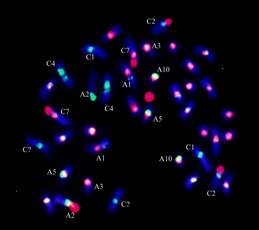These are Brassica napus synthetic lines developed by J. Chris Pires' lab. A= are rapa and C are oleracea chromosomes. Fluorescent dyes were used to to "paint" specific chromosomes and track their migration within particular hybrids. Credit: Image by J. Chris Pires
A University of Arkansas researcher and her colleagues are developing a way to examine how the genomes rearrange themselves during hybridization to better pinpoint how genetically modified organisms may behave when they cross with naturally occurring plants.
Cindy Sagers, associate professor of biological sciences in the J. William Fulbright College of Arts and Sciences; Chris Pires, assistant professor of biological sciences at the University of Missouri, Columbia; and C. Neal Stewart Jr., professor of plant sciences at the University of Tennessee are examining chromosomes using specific dyes to look at how a particular trait – say herbicide resistance – passes from one type of plant to another.
“Transgenic plants that escape into nature could become a very serious problem,” Sagers said. Some types of plants, such as canola, creeping bentgrass and rice, have mobile pollen that can cross-pollinate with relatives and related weeds, which in turn can take on the genetically modified trait. This could translate into herbicide-resistant weeds that can wipe out crop fields, or non-modified crops contaminated with modified genes – both scenarios that have happened.
Sagers and Pires have applied for a Biotechnology Risk Assessment Grant from the United States Department of Agriculture to examine how the genome rearranges itself when genetically modified organisms and wild plants hybridize. They will use fluorescent dyes to “paint” specific chromosomes and track their migration within particular hybrids. This will allow the researchers to determine what specific pairings of populations create viable hybrids with genetically modified components.
The scientists will use a relative of Arabidopsis for their research. Known as “the lab rat of the plant world,” the genetic sequence of Arabidopsis is well documented, allowing the researchers to develop detailed examinations of changes to the chromosomes in the canola crop genome.
By examining the issue of gene transfer at the chromosomal level, the researchers will be able to determine how novel genes transfer from a genetically modified crop into a weed or natural crop. This knowledge will help scientists working with genetically modified crops to better control and regulate the reproduction of desirable genes in the appropriate plants.
Sagers spent a year on a fellowship at an Environmental Protection Agency laboratory in Corvallis, Ore., studying the potential cross-pollination of herbicide resistant genes in canola. Canola makes a good experimental model because of its short life cycle, its reproduction from seeds and its ability to hybridize with close relatives.
They measured and weighed the parent and hybrid plants to see which ones fared better in highly competitive environments under selection by insect pests. The hybrids grew to be almost 15-fold larger than the parent plants.
“We know that there is hybrid vigor in the system,” Sagers said. “We also know that these hybrids can persist in the wild.”
Source: University of Arkansas, Fayetteville
























